
Roanoke is an independent city in the U.S. state of Virginia. It is located in Southwest Virginia along the Roanoke River, in the Blue Ridge range of the greater Appalachian Mountains. Roanoke is approximately 50 miles (80 km) north of the Virginia–North Carolina border and 250 miles (400 km) southwest of Washington, D.C., along Interstate 81. At the 2020 census, Roanoke's population was 100,011, making it the largest city in Virginia west of the state capital Richmond. It is the primary population center of the Roanoke metropolitan area, which had a population of 315,251 in 2020.

Prestwould is a historic house near Clarksville, Virginia. It is the most intact and best documented plantation surviving in Southside Virginia. The house was built by Sir Peyton Skipwith, 7th Baronet Skipwith, who moved his family from his Elm Hill Plantation to Prestwould in 1797. It was declared a National Historic Landmark in 2003. It is located on the north side of the Roanoke River, 1-mile (1.6 km) inland, approximately 6 miles (9.7 km) southwest of the intersection of Route 15 and Route 701, and approximately one mile north of Clarksville's town limits. Now a museum property, it is open for tours from April to October, or by appointment.

Mountain View is a Roanoke, Virginia neighborhood located in central Roanoke north of the Roanoke River. It borders the neighborhoods of Norwich on the west, West End on the east, Hurt Park on the north and Raleigh Court and Wasena on the south.
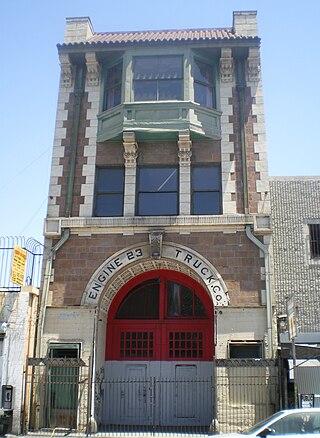
Fire Station No. 23 is a former fire station in Downtown Los Angeles. Built in 1910 as an operating fire station, it was also the Los Angeles Fire Department's headquarters until 1920 and the residence of every fire chief from 1910 to 1928. When it opened, it spawned a political firestorm due to the ornate interior and expensive imported materials, leading to its being called the "Taj Mahal" of firehouses. After 50 years of operation, the station was closed in 1960 as the department began replacing older stations with new facilities. Since the 1980s, Fire Station No. 23 has been a popular filming location. Motion pictures filmed at the station include the Ghostbusters movies, The Mask, Police Academy 2, Flatliners, Firehouse and National Security.
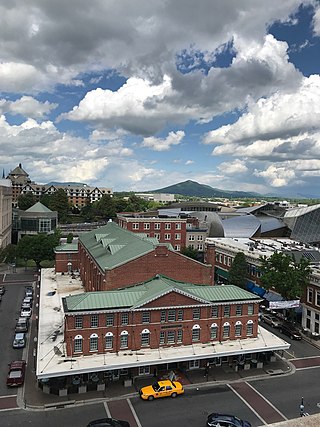
Roanoke City Market Historic District, also known as City Market District, is a national historic district located in the Downtown Roanoke area of Roanoke, Virginia.

Fire Station No. 1 is a former fire station listed on the National Register of Historic Places in the Downtown neighborhood of the independent city of Roanoke, Virginia, United States. Modeled after Philadelphia's Independence Hall, Fire Station No. 1 served as one of the longest continuously operating fire stations in the Commonwealth of Virginia from its completion in 1907 through the opening of a replacement facility in 2007. Designed by the Lynchburg firm of Huggins and Bates, No. 1 still stands as a monument to the civic pride of early Roanoke. It is located in the Roanoke City Market Historic District.
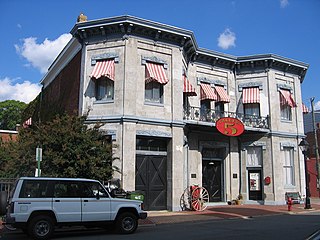
Steamer Company Number 5 is a former Richmond fire station located at 200 West Marshall Street in Richmond, Virginia.

Portland Fire Station No. 7, located in southeast Portland in the U.S. state of Oregon, is a two-story structure listed on the National Register of Historic Places. Built in 1927, it was added to the register in 1989. It was the last of numerous Portland firehouses to be designed by fire chief and architect Lee Gray Holden, who died of a stroke while visiting the No. 7 firehouse in 1943. The building continued to be used by the city's Fire Department until the 1980s, when it was sold off and used as an automobile garage. It was acquired by a local developer in 2009, and was restored and remodeled for office and retail use.

Fire Station No. 23 is a former fire station located in the Central District of Seattle, Washington listed on the National Register of Historic Places. It was remodeled as the Cherry Hill Community Center in 1970, and served as the headquarters of Centerstone. It was again renamed in 2018 to Byrd Barr Place. This was done to honor local US civil rights leader Roberta Byrd Barr, who is cited as strong supporter of CAMP's efforts since the 1960s. The location currently offers community support to the surrounding Seattle area, including housing assistance, tackling food insecurity, and bringing the community together to advocate for its needs. Byrd Bard Place seeks to support Black Washingtonian's within Seattle's Central District in particular, with the end goal of bettering the state of Washington collectively.

Mount Moriah Baptist Church and Cemetery is a historic African-American Baptist church and cemetery located at Roanoke, Virginia. It was built about 1908, and is a small, one-story, rectangular frame church sheathed in weatherboard. It consists of a main sanctuary, a front vestibule, and a rear chancel bay. The frame building sits on a raised foundation of uncoursed fieldstones. The associated burial ground contains over 100 interments from the 1870s through the present.

Harrison School is a historic public school building for African-American students located in Roanoke, Virginia. It is a rectangular, 13-bay brick building done in modified Georgian Revival architecture. The school was built in 1916 with two-story wings added in 1922. It was the first school in the city to educate black students beyond the seventh grade level, and its first principal was the noted educator Lucy Addison. After closing as a school in the 1960s, the building served as a child care center and later low-income housing as well as the home of the Harrison Museum of African American Culture.

Norfolk and Western Railway Company Historic District is a national historic district located in Roanoke, Virginia. It encompasses three contributing buildings constructed by the Norfolk and Western Railway (N&W). They are the Neoclassical Revival style General Office Building–South ; the Art Deco period General Office Building–North (1931); and the Moderne style Passenger Station.

The Gainsboro Branch of the Roanoke City Public Library, also known as the Gainsboro Library, is a historic library building located in the African-American neighborhood of Gainsboro in Northwest Roanoke, Virginia. It was built in 1941–1942, and is a one-story, seven-bay brick building built with an L-plan and gabled roof, and designed in the Tudor Revival style. The library's history dates to 1921 as the fourth established African-American library in the Southern United States. It is home to a significant Black history collection that was gradually amassed by longtime librarian Virginia Lee. After being told by city officials to remove the items, Lee hid them instead and kept them available for patrons. The collection is now on display in a room dedicated for and named after Lee, and the library has seen recognition for its role in preserving the area's African-American heritage.

Belmont Methodist-Episcopal Church is a historic church building, located in the Belmont neighborhood of Roanoke, Virginia. It was built as a Methodist Episcopal church between 1917 and 1921, and is a three-story, brick, late Gothic Revival-style church. It features a tall bell tower, complex roof form, steeply-pitched gables and parapets, large pointed arch windows, crenellated corner towers, buttresses, cast-concrete quatrefoils, and other detailing. Capacity within sight and hearing of the pulpit is 1,000, as the original auditorium was enlarged with an adjoining parlor (75), an adult assembly room (260), and a gallery (225).

Fire Station No. 5 in Roanoke, Virginia is a former fire station at 216 12th Street NW, in the independent city of Roanoke. The neighborhood fire station was one of three built in 1911, and was designed to look like a house, blending into its residential neighborhood. It housed one of the city's first fire trucks to be powered by an internal combustion engine. It served the city as a fire station until 2010, when it was turned over to a local nonprofit organization.
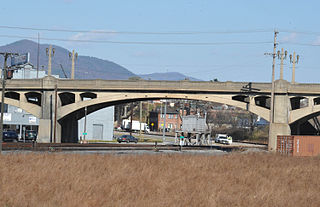
The Roanoke River and Railroad Historic District is a predominantly industrial area on the north side of the Roanoke River in Roanoke, Virginia. The area is bounded by South Jefferson Street on the west and the Roanoke River to the east, and extends north as far as Albemarle Avenue. The district's resources are defined primarily by their relationship to the railroad tracks that bisect this area. The area was developed in the late 19th and early 20th centuries with the completion of the Roanoke & Southern line in 1892 and the Virginian Railway line in 1909, and consists primarily of functional industrial buildings that were built between about 1900 and 1930, an example of which is the Virginia Can Company. Notable exceptions are the Virginian Railway Passenger Station, a Spanish Revival passenger station built 1909-10 and listed on the National Register of Historic Places since 2003, and the Walnut Street and Jefferson Street bridges, completed in 1927 and 1928, respectively. Both bridges were constructed in the Art Deco style and designed with "Egyptian Babylonian" style decorations.
Gustave A. Sedon, also known as Gustavus Sedon, was a carpenter and craftsman in nineteenth century Roanoke, Virginia. He is noted for his work on various public buildings, plantation homes, and university structures. Sedon is known primarily for his ornamental work on buildings, many of which are now listed on the National Register of Historic Places.

The Villa Heights house, also known as the Compton–Bateman House, is a historic house in Roanoke, Virginia, USA. Built in 1820, it was originally the home of Elijah McClanahan, a lieutenant-colonel in the War of 1812. It has been substantially renovated and restored over the years, including after a 2011 fire, and it is the namesake of the neighborhood of Villa Heights, Roanoke, Virginia. It was added to the National Register of Historic Places in 2018, and as of 2023 houses assorted non-profit groups.

The English Gardens Apartments is a historic complex of apartment buildings located in Roanoke, Virginia. The complex was designed by the Richmond-based architect E. Tucker Carlton, and was built in two phases. The first, completed in 1947, consists of nine building of three stories each, while the second, finished in 1950, consists of eight buildings of two stories each. The complex was designed in the Colonial Revival style, and all buildings are constructed of concrete blocks fronted with brick.
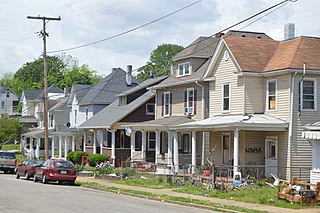
The Belmont Historic District is located in the southeast section of Roanoke, Virginia, US. It consists of an irregularly-shaped 214 acres (87 ha) of primarily residential housing located to the east of the city's downtown and south of the Roanoke Shops.























